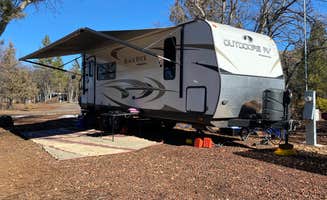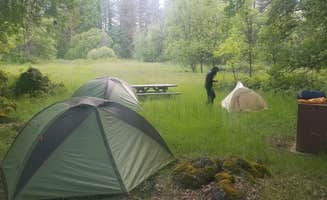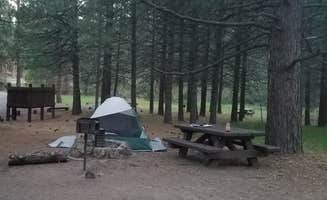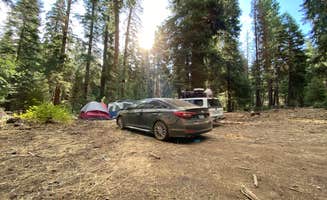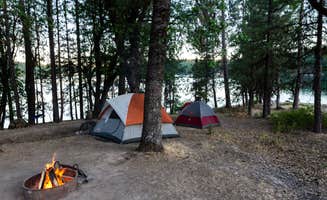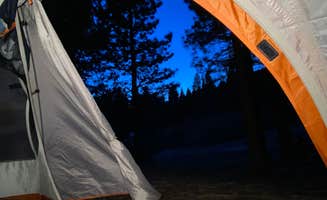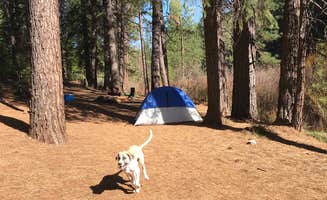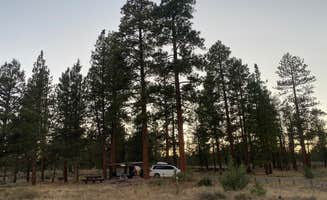Dispersed camping opportunities in Modoc National Forest extend across northeastern California between elevations of 4,000 and 8,000 feet. The forest spans over 1.6 million acres with distinct volcanic features and high desert terrain. Summer temperatures often reach 90°F in lower elevations while dropping below freezing at night in higher regions.
What to do
Cave exploration at Lava Beds National Monument: Drive approximately 20 minutes from Indian Well Campground to explore the largest concentration of lava tubes in the world. "Headlamp and helmet are musts. Gloves and kneepads recommended if you're planning on crawling around," recommends Dan X. The monument features over 30 accessible caves ranging from beginner-friendly to challenging technical routes.
Birding along forest trails: The Modoc region serves as a critical habitat for migratory birds. "Trails like this one lead right from camp. Bring your binoculars," notes Ryan W. about Howard's Gulch. Some campgrounds connect directly to the Basin & Range Birding Trail system that stretches across northern California and southern Oregon.
Fishing in forest reservoirs: Duncan Reservoir South Site offers free camping near fishing opportunities. "Found this unmapped camping spot by following a USFS access road to an old boat launch area," reports Cheryl M. Though water levels fluctuate seasonally, the reservoir supports trout fishing during spring and early summer months.
What campers like
Stargazing opportunities: Clear night skies with minimal light pollution make this region ideal for astronomy. "Good visibility for our Starlink. And we have T-Mobile and were able to make calls and text and access the internet," notes Hilary S. about Lava Beds National Monument Road dispersed camping area.
Quiet, uncrowded camping: Many campers appreciate the solitude found at Modoc National Forest campsites. "We didn't have too many people there but it was a gorgeous sight!" reports Christopher about Lower Rush Creek Campground. Even during peak summer months, campers can often find available sites without reservations.
Wildlife viewing: The forest provides habitat for deer, eagles, and other wildlife. "Woke up to deer in my camp," shares Mack S. about Indian Well Campground. The nearby Tule Lake National Wildlife Refuge offers additional wildlife viewing with "a reserve where you can always see eagles," according to MarinMaverick.
What you should know
Fire restrictions vary by location and season: Always check current regulations before planning campfires. "You should be careful to read about fire restrictions in the area," advises Alex P. about Lower Rush Creek Campground. Some areas maintain year-round fire bans while others allow fires in designated fire rings only.
Water availability is limited: Many dispersed sites and some established campgrounds lack potable water. "The pit toilets were decently clean, but quite dark inside. There are water spigots, but no water comes out - we later saw a sign posted saying that the water system was shut off," notes Alex P. about Lower Rush Creek.
Access roads vary in quality: Some campgrounds require travel on unpaved roads. "The dirt road is ok but there were a few dips and ruts that we had to go around," reports Laura M. about West Tionesta dispersed area. Check road conditions before traveling, especially after rainfall or snowmelt.
Tips for camping with families
Choose sites with playground amenities: Hawk's Nest Tionesta RV & Cabins provides family-friendly facilities. "This campsite is nestled in the forest away from the highway. It has cabins, RV, and tent camping available. There is a new playground for children," notes Amber Z.
Visit during educational ranger programs: Indian Well Campground's proximity to the Lava Beds visitor center allows families to participate in ranger-led activities. "Staying at this campground makes it easy and possible to stay late exploring the lava tubes and getting right back to it in the morning," recommends The School for Y.
Pack for temperature fluctuations: "Caution. It is very hot and dry here in the summer! We go here in the spring and fall to avoid the heat," warns MarinMaverick. Even summer nights can be cool, with temperatures sometimes dropping 40 degrees from daytime highs.
Tips from RVers
Know your size limitations: Many forest campgrounds have restrictions for larger vehicles. "The loop around is tight, but you could probably get through with a 24 or 25 foot trailer if you were careful. I wouldn't try anything bigger than that though," advises Jordan B. about Lower Rush Creek Campground.
Utilize full hookup options for longer stays: Eagle's Nest RV Park offers complete amenities near Lava Beds National Monument. "Quiet, Large, pull through, full hook up sites. The internet actually works!" reports Beth D. The park also features a dump station and trash facilities.
Plan for possible wildlife encounters: Secure food storage is essential in this forest. "All pull through sites big enough to keep toad hooked up," mentions Carol about Hawk's Nest Tionesta RV & Cabins, which provides organized sites away from natural brush where wildlife might approach vehicles.




